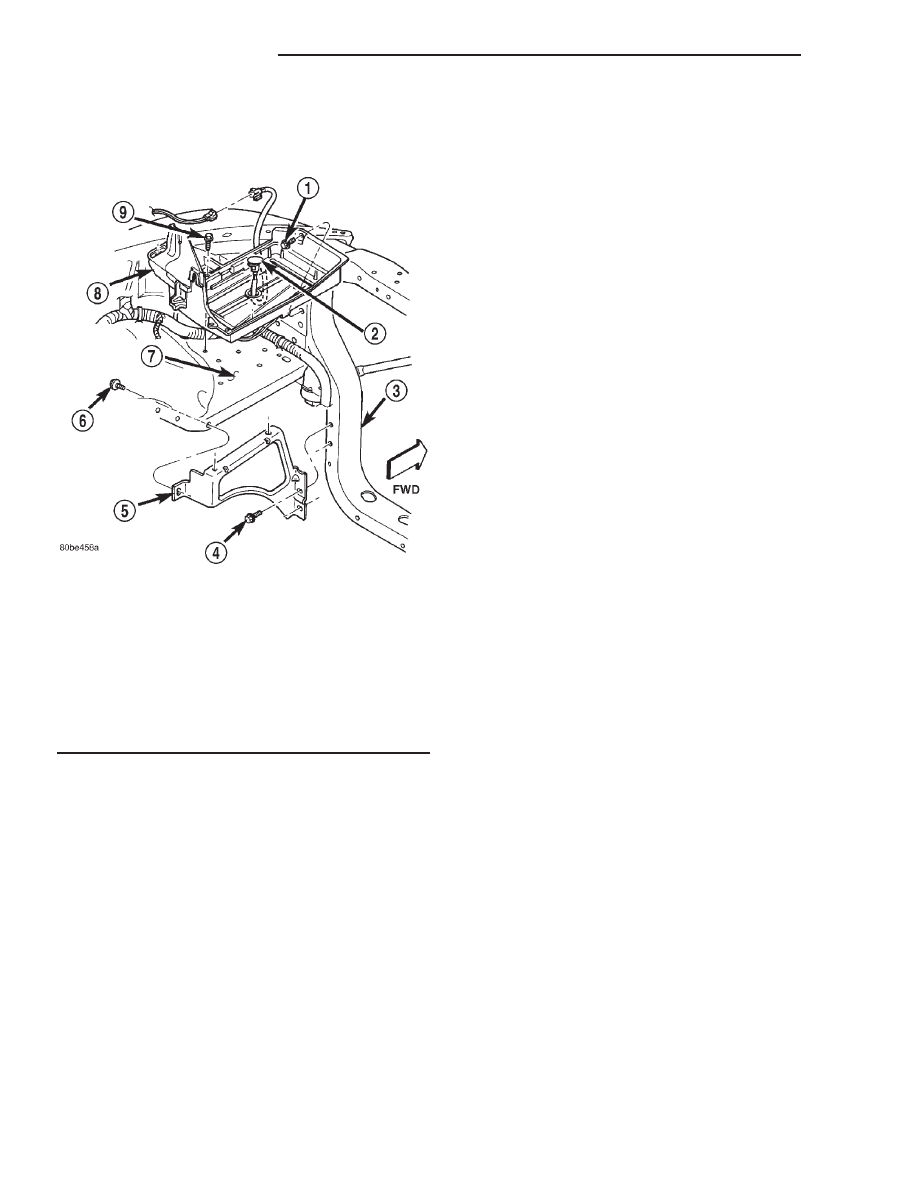Dodge Dakota (R1). Manual - part 300

BATTERY TRAY
DESCRIPTION
The battery is mounted in a molded plastic tray
(Fig. 25) located in the left front corner of the engine
compartment. The battery tray is secured on the
inboard side with screws to a stamped steel battery
tray support located on the left side of the radiator,
on the outboard side with screws to the front exten-
sion of the left front wheelhouse inner panel and at
the front to the front closure panel on the left side of
the radiator yoke. The battery tray support is
secured at the front with screws to the left side of
the radiator yoke, and at the rear with a screw to the
front extension of the left front wheelhouse inner
panel.
A hole in the bottom of the battery tray is fitted
with a battery temperature sensor. Refer to Battery
Temperature Sensor in the index of this service
manual for the location of more information on the
battery temperature sensor. The battery tray also
includes two stanchions that are molded into the rear
of the tray, which support the forward end of the
Power Distribution Center (PDC). Refer to Power
Distribution Center in the index of this service
manual for the location of more information on the
PDC mounting.
OPERATION
The battery tray provides a secure mounting loca-
tion and supports the battery. On some vehicles, the
battery tray also provides the anchor point/s for the
battery holddown hardware. The battery tray and
the battery holddown hardware combine to secure
and stabilize the battery in the engine compartment,
which prevents battery movement during vehicle
operation. Unrestrained battery movement during
vehicle operation could result in damage to the vehi-
cle, the battery, or both.
REMOVAL
(1) Remove the battery from the battery tray.
Refer to Battery in the index of this service manual
for the location of the proper battery removal proce-
dures.
(2) Remove the Power Distribution Center (PDC)
from the stanchions on the rear of the battery tray.
Refer to Power Distribution Center in the index of
this service manual for the location of the proper
PDC removal procedures.
(3) Remove the two screws that secure the inboard
side of the battery tray to the battery tray support
(Fig. 26).
(4) Remove the two screws that secure the out-
board side of the battery tray to the front extension
of the left front wheelhouse inner panel.
(5) Remove the one screw that secures the front of
the battery tray to the front closure panel on the left
side of the radiator yoke.
(6) Remove the battery temperature sensor from
the battery tray. Refer to Battery Temperature
Sensor in the index of this service manual for the
location of the proper battery temperature sensor
removal procedures.
(7) Remove the battery tray from the battery tray
support and the front extension of the left front
wheelhouse inner panel.
(8) Remove the one screw that secures the rear of
the battery tray support to the front extension of the
left front wheelhouse inner panel.
(9) Remove the two screws that secure the front of
the battery tray support to the left side of the radia-
tor yoke.
(10) Remove the battery tray support from the left
front wheelhouse inner panel and the left side of the
radiator yoke.
Fig. 25 Battery Tray
1 - SCREW
2 - SENSOR
3 - YOKE
4 - SCREW
5 - SUPPORT
6 - SCREW
7 - WHEELHOUSE INNER PANEL
8 - TRAY
9 - SCREW
8F - 22
BATTERY SYSTEM
AN